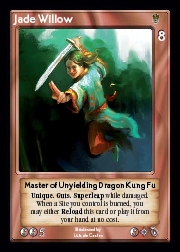
With pretty much everyone I know that plays Shadowfist moving to the four corners of the country and beyond, it’s been tough to keep the faith–even with my whirlwind of playing during Gencon every summer– it’s just not enough! So thanks to everyone that got in on the 5 or so games we threw down this week.
That said, it’s still difficult to even discuss getting new players into a game like this except casually. There has to be massive trepidation on anyone’s part who remembers the 90’s around getting into a CCG for any reason– even one as fun and accessible as Shadowfist. Even if someone hands a new player a deck and a shoebox full of cards, if you want to really get into it, it’s still shockingly expensive compared to board-gaming and even miniature gaming. New expansions cost around 120$ to get a full set (with the commons and uncommons you need to flesh it out) and the search for various rares can get both frustrating and expensive.
The advantage of Shadowfist is that, unlike Magic, cards have become more powerful as the years and expansions go on– most early cards that are difficult to get have either been eclipsed by new cards or have been reprinted: this is the exact opposite of Magic, where the most powerful cards are never reprinted. Rares, typically, are cards that you only need one or two of unless you are building something really weird so though you may chase down Ting Ting (‘The’ chase card until her reprint in 2001)– you really only need 1-2 copies if you are building a single deck around her (which MANY people have). I run out of cards while making decks a lot (mostly uncommons) but I have 20+ decks lying around, I can’t imagine playing the game focusing on just one faction, or just a couple of decks– but that’s what new players are faced with: it’s prohibitively expensive to collect to a level where you are focusing on multiple factions in relation to the current big deal: boardgames.
So every worm turns and eventually people will probably get back into the CCG’s a bit as a gaming culture, but probably long after we stop seeing Yugioh packs in Walmart. Magic, while I have no interest in the game itself, is keeping the faith by it’s tenacious continued existence. Back in the day–well, 90’s, there were miniature gamers that had no qualms about dropping a shitload of cash (and time) on their armies and a lot of that attitude translated to the CCG’s when their time in the sun came. The issue I see going forward with the board game crowd is that a gaming group collectively can amass a gigantic board game collection for fractions of the cost to truly get into a CCG. A single boardgame may not get even near the play of a CCG, but since there are so many boardgames owned by a group, there’s a ton of variety.
However my favorite type of game– multiplayer asymmetrical strategy– is without a doubt represented best by CCG’s to the point where nothing else comes close to the richness and myriad of choices, situations and metagame. Even my favorite asymmetrical board games feel like short, clipped experiences compared to the metagame analysis, deck building, tweaking and then (the best part) playing a muliplayer CCG. Though boardgaming is the rage right now, and people poo poo even the very idea of a CCG due to the perception of predatory pricing and rare card modelling (especially in the case of Magic) I think it’s an amazing form of gaming that captured the gaming world’s attention for more than a decade right when the time of the computer and console game was coming into it’s own as a form of entertainment bigger than television.
Though I won’t sing a lament for games such as Rage, Blood Wars or Arcadia, there are a few CCG’s whose awesomeness as the ultimate experience in multiplayer asymmetrical strategy games cannot be denied, Shadowfist being the hands down best but Jyhad, Doomtown and Legend of the Burning Sands /Legend of Five Rings are in the ranks of praise as well.
 Fittingly, the first post of a new blog about gaming should be about a game I rarely get to play these days that has, since it’s first expansion, been all-holes-filled with totally awesome: Shadowfist. With the most recent expansion:
Fittingly, the first post of a new blog about gaming should be about a game I rarely get to play these days that has, since it’s first expansion, been all-holes-filled with totally awesome: Shadowfist. With the most recent expansion: